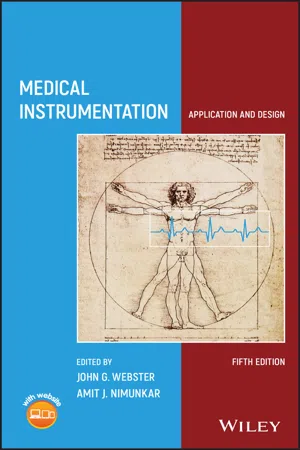
- English
- ePUB (mobile friendly)
- Available on iOS & Android
About this book
Provides a comprehensive overview of the basic concepts behind the application and designs of medical instrumentation
This premiere reference on medical instrumentation describes the principles, applications, and design of the medical instrumentation most commonly used in hospitals. It places great emphasis on design principles so that scientists with limited background in electronics can gain enough information to design instruments that may not be commercially available. The revised edition includes new material on microcontroller-based medical instrumentation with relevant code, device design with circuit simulations and implementations, dry electrodes for electrocardiography, sleep apnea monitor, Infusion pump system, medical imaging techniques and electrical safety. Each chapter includes new problems and updated reference material that covers the latest medical technologies.
Medical Instrumentation: Application and Design, Fifth Edition covers general concepts that are applicable to all instrumentation systems, including the static and dynamic characteristics of a system, the engineering design process, the commercial development and regulatory classifications, and the electrical safety, protection, codes and standards for medical devices. The readers learn about the principles behind various sensor mechanisms, the necessary amplifier and filter designs for analog signal processing, and the digital data acquisition, processing, storage and display using microcontrollers. The measurements of both cardiovascular dynamics and respiratory dynamics are discussed, as is the developing field of biosensors. The book also covers general concepts of clinical laboratory instrumentation, medical imaging, various therapeutic and prosthetic devices, and more.
- Emphasizes design throughout so scientists and engineers can create medical instruments
- Updates the coverage of modern sensor signal processing
- New material added to the chapter on modern microcontroller use
- Features revised chapters, descriptions, and references throughout
- Includes many new worked out examples and supports student problem-solving
- Offers updated, new, and expanded materials on a companion webpage
- Supplemented with a solutions manual containing complete solutions to all problems
Medical Instrumentation: Application and Design, Fifth Edition is an excellent book for a senior to graduate-level course in biomedical engineering and will benefit other health professionals involved with the topic.
Frequently asked questions
- Essential is ideal for learners and professionals who enjoy exploring a wide range of subjects. Access the Essential Library with 800,000+ trusted titles and best-sellers across business, personal growth, and the humanities. Includes unlimited reading time and Standard Read Aloud voice.
- Complete: Perfect for advanced learners and researchers needing full, unrestricted access. Unlock 1.4M+ books across hundreds of subjects, including academic and specialized titles. The Complete Plan also includes advanced features like Premium Read Aloud and Research Assistant.
Please note we cannot support devices running on iOS 13 and Android 7 or earlier. Learn more about using the app.
Information
1
BASIC CONCEPTS OF MEDICAL INSTRUMENTATION
1.1 TERMINOLOGY OF MEDICINE AND MEDICAL DEVICES
Table of contents
- Cover
- Table of Contents
- ACKNOWLEDGMENTS
- PREFACE
- LIST OF SYMBOLS
- 1 BASIC CONCEPTS OF MEDICAL INSTRUMENTATION
- 2 BASIC SENSORS AND PRINCIPLES
- 3 MICROCONTROLLERS IN MEDICAL INSTRUMENTATION
- 4 THE ORIGIN OF BIOPOTENTIALS
- 5 BIOPOTENTIAL ELECTRODES
- 6 BIOPOTENTIAL AMPLIFIERS
- 7 BLOOD PRESSURE AND SOUND
- 8 MEASUREMENT OF FLOW AND VOLUME OF BLOOD
- 9 MEASUREMENTS OF THE RESPIRATORY SYSTEM
- 10 CHEMICAL BIOSENSORS
- 11 CLINICAL LABORATORY INSTRUMENTATION
- 12 MEDICAL IMAGING SYSTEMS
- 13 THERAPEUTIC AND PROSTHETIC DEVICES
- 14 ELECTRICAL SAFETY
- APPENDIX
- Index
- End User License Agreement